Electrostatic fields - Study guides, Class notes & Summaries
Looking for the best study guides, study notes and summaries about Electrostatic fields? On this page you'll find 142 study documents about Electrostatic fields.
Page 2 out of 142 results
Sort by
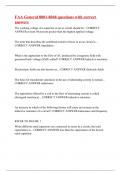
-
FAA General 8001-8048 questions with correct answers
- Exam (elaborations) • 8 pages • 2023
- Available in package deal
-
- $12.99
- + learn more
The working voltage of a capacitor in an ac circuit should be... CORRECT ANSWER at least 50 percent greater than the highest applied voltage. The term that describes the combined resistive forces in an ac circuit is... CORRECT ANSWER impedance. What is the opposition to the flow of AC produced by a magnetic field with generated back voltage (EMF) called? CORRECT ANSWER Inductive reactance Electrostatic fields are also known as... CORRECT ANSWER dielectric fields The basis for transfo...
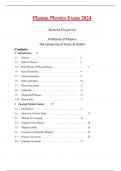
-
Plasma Physics Exam 2024
- Exam (elaborations) • 242 pages • 2024
-
- $23.99
- + learn more
Plasma Physics Exam 2024 1.5 Plasma Frequency The plasma frequency, 2 = ne2 , (1.5) ωp ǫ0 m is the most fundamental time-scale in plasma physics. Clearly, there is a different plasma frequency for each species. However, the relatively fast electron frequency is, by far, the most important, and references to “the plasma frequency” in text-books invariably mean the electron plasma frequency. It is easily seen that ωp corresponds to the typical electrostatic oscillation frequency of a...
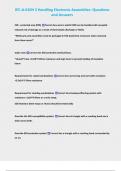
-
IPC-A-610H 3 Handling Electronic Assemblies- Questions and Answers
- Exam (elaborations) • 2 pages • 2024
- Available in package deal
-
- $7.99
- + learn more
IPC-A-610H 3 Handling Electronic Assemblies- Questions and Answers ESD - protected area (EPA) Correct Ans-area in which ESDS can be handled with accepted reduced risk of damage as a result of electrostatic discharge or fields; *ESDS parts and assemblies must be packaged in ESD protective enclosures when removed from these areas!*
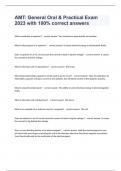
-
AMT: General Oral & Practical Exam 2023 with 100% correct answers
- Exam (elaborations) • 40 pages • 2023
- Available in package deal
-
- $15.49
- + learn more
What constitutes a capacitor? - correct answer Two conductors separated by an insulator. What is the purpose of a capacitor? - correct answer It stores electrical energy in electrostatic fields. Does a capacitor in an AC circuit cause the current to lead or lag the voltage? - correct answer It causes the current to lead the voltage. What is the basic unit of capacitance? - correct answer The ferad. Why should electrolytic capacitors not be used in an AC circuit? - correct an...
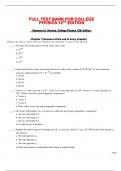
-
Test Bank for College Physics, 12th Edition by Raymond A. Serwa|| Complete Guide A+
- Exam (elaborations) • 672 pages • 2024
-
- $18.04
- + learn more
Test Bank Test Bank for College Physics 12e 12th Edition by Raymond A. Serway, Chris Vuille, John Hughes. Full Chapters test bank are included with answers (Chapter 1 to 30) Complete Guide 1. Units, Trigonometry, and Vectors. Standards of Measurements. Measurement Uncertainty and Estimation. Math Review. Vectors. Overview of Physics. 2. Motion in One Dimension. Displacement, Velocity, and Acceleration. Motion Diagrams and Graphs. One-Dimensional Motion with Constant Acceleration. Freely Falling...
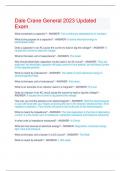
-
Dale Crane General 2023 Updated Exam
- Exam (elaborations) • 32 pages • 2023
- Available in package deal
-
- $12.99
- + learn more
Dale Crane General 2023 Updated Exam What constitutes a capacitor? - ANSWER- Two conductors separated by an insulator. What is the purpose of a capacitor? - ANSWER- It stores electrical energy in electrostatic fields. Does a capacitor in an AC cause the current to lead or lag the voltage? - ANSWER- It causes the current to lead the voltage. What is the basic unit of capacitance? - ANSWER- The farad. Why should electrolytic capacitors not be used in an AC circuit? - ANSWER- They are ...
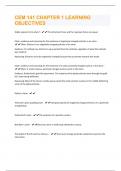
-
CEM 141 CHAPTER 1 LEARNING OBJECTIVES QUESTIONS WITH A GUARANTEED A+
- Exam (elaborations) • 4 pages • 2023
- Available in package deal
-
- $7.19
- + learn more
Stable systems form when? - The attractive forces and the repulsive forces are equal. Claim, evidence and reasoning for the existence of negatively charged particles in an atom. - Claim: Electron's are negatively charged particles of an atom. Evidence: JJ's cathode ray. Electron's were ejected from the cathode, regardless of what the cathode was made of. Reasoning: Electrons must be negatively charged because they accelerate towards the anode. Claim, evidence and reasoning for the exist...
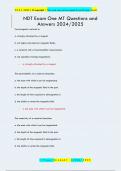
-
NDT Exam One MT Questions and Answers 2024/2025
- Exam (elaborations) • 17 pages • 2024
-
- $12.49
- + learn more
Ferromagnetic material is: a. strongly attracted by a magnet. b. not highly saturated by magnetic fields. c. a material with a 0 permeability measurement. d. not capable of being magnetized. a. strongly attracted by a magnet. The permeability of a material describes: a. the ease with which it can be magnetized. b. the depth of the magnetic field in the part. c. the length of time required to demagnetize it. d. the ability to retain the magnetic field. a. the ease with which it...
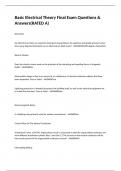
-
Basic Electrical Theory Final Exam Questions & Answers(RATED A)
- Exam (elaborations) • 9 pages • 2024
-
- $12.99
- + learn more
Electricity: An electrical arc blast can vaporize metal parts and produces an explosive and deadly pressure wave. How many degrees fahrenheit can an electrical arc blast reach? - ANSWER30,000 degrees Fahrenheit Electric Motors: Does the electric motor work on the principle of the attracting and repelling forces of magnetic fields? - ANSWERYes Electrostatic charge is due to an excess of, or a deficiency of, electrons between objects that have been separated. True or False? - ANSWERTru...
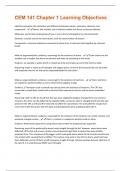
-
CEM 141 Chapter 1 Learning Objectives Questions with well explained answers
- Exam (elaborations) • 3 pages • 2024
- Available in package deal
-
- $7.99
- + learn more
Identify and explain the similarities and differences between atoms, molecules, elements, and compounds - Atoms: the smallest unit of ordinary matter that forms a chemical element Molecules: electrically neutral group of two or more atoms held together by chemical bonds. Elements: consists only of the same atoms, with the same number of protons Compounds: a chemical substance composed of atoms from 2+ elements held together by chemical bonds Make an argument(claim, evidence, reasoning) for...

That summary you just bought made someone very happy. Also get paid weekly? Sell your study resources on Stuvia! Discover all about earning on Stuvia


